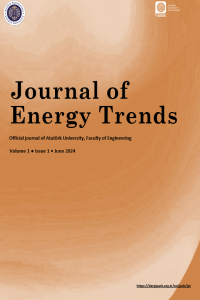Comparative Analysis of the Effect of Replacing Central System Heating and Cooling with Vrf Technology on Energy Efficiency
Abstract
In today's context, energy consumption and environmental impacts have become a significant focus in the design of heating and cooling systems. In this regard, the replacement of traditional central heating and cooling systems with Variable Refrigerant Flow (VRF) technology deserves a comprehensive evaluation considering its effects on energy efficiency. This article provides a detailed analysis, focusing on the advantages of adopting VRF technology in terms of energy savings, operational costs, and environmental sustainability, comparing it with traditional systems.
VRF technology allows systems to operate flexibly and efficiently through variable refrigerant flow control. While traditional systems often operate at a fixed speed, the dynamic control feature of VRF adapts to varying heat demands in different building zones, thereby increasing energy efficiency. Known for its ability to respond instantly to user needs, this technology optimizes energy consumption accordingly.
The article also addresses the financial aspect of the system change. By examining operating costs, the long-term cost advantages of VRF technology will be determined. Financial analysis plays a critical role in evaluating how economically viable such a transition is for companies and facilities.
This study examines the heat loss and gain reports of a 1000-person Student Dormitory in Mersin, commissioned by the Ministry of Youth and Sports. The cooling load for the mentioned male student dormitory is calculated as Zon-1=469,650 kcal/h, Zon-2=540,950 kcal/h, Zon-3=559,150 kcal/h, totaling 1,569,750 kcal/h, and the heating load is calculated as 292,611 kcal/h. Based on the calculated heat loss and gain loads, selections of Fan Coil Unit (FCU) and VRF have been made.
A comparison and analysis of the selected FCU and VRF equipment have been conducted. The analysis reveals that the VRF system is 28% more efficient in terms of operating costs. Considering operating expenses and energy consumption in the heating and cooling system for the dormitory, implementing the VRF system is deemed more economical. The FCU system is converted to a VRF system, and the project is revised and implemented.
In conclusion, this study provides a comprehensive analysis of replacing VRF technology with central heating and cooling systems in terms of energy efficiency, cost-effectiveness, and environmental sustainability. The article is expected to be a valuable resource for industry professionals, engineers, and energy experts.
References
- Aynur, T.N., Hwang, Y., & Radermacher, R. (2006). Field Performance Measurements of a VRV AC/HP System, 11th International Refrigeration and Air Conditioning Conference, Purdue, IN-USA, 1-8.
- Hai, X.H., Jun, S., Hand, Z.Y., & Bin, T.C. (2006a). Design and research of the digital VRV multiconnected units with three pipes type heat recovery system, 11th International Refrigeration and Air Conditioning Conference, IN, USA, 1-5.
- Hai, X.H., Tao, Z., Yun, F.H., & Jun, S. (2006b). Design and research of the commercial digital VRV multi-connected units with sub-cooled ice storage system, 11th International Refrigeration and Air Conditioning Conference, IN, USA, 1-5.
- Masuda, M., Wakahara, K., & Matsuki, K. (1991). Development of a multi-system air conditioner for residential use. ASHRAE Transactions, 97(2), 127-131.
- Özsoy M., Yücel C., Varlıca O., Kılıç S., & Kaplan, K. (2019). Optimization of Air Distribution in A Non-Ducted Concealed Type Fan Coil Unit Heat Exchanger, 5 (3), 124-130.
- Park, Y.C., Kim, Y.C., & Min, M.K. (2001). Performance analysis of a multi-type inverter air conditioner, Energy Conversion and Management, 42 (13), 1607–1621.
- Xia, J., Winandy, E., Georges, B., & Lebrun, J. (2002). Testing methodology for VRF systems, 9th International Refrigeration and Air Conditioning Conference, Purdue, IN, USA, 1-8.
Abstract
References
- Aynur, T.N., Hwang, Y., & Radermacher, R. (2006). Field Performance Measurements of a VRV AC/HP System, 11th International Refrigeration and Air Conditioning Conference, Purdue, IN-USA, 1-8.
- Hai, X.H., Jun, S., Hand, Z.Y., & Bin, T.C. (2006a). Design and research of the digital VRV multiconnected units with three pipes type heat recovery system, 11th International Refrigeration and Air Conditioning Conference, IN, USA, 1-5.
- Hai, X.H., Tao, Z., Yun, F.H., & Jun, S. (2006b). Design and research of the commercial digital VRV multi-connected units with sub-cooled ice storage system, 11th International Refrigeration and Air Conditioning Conference, IN, USA, 1-5.
- Masuda, M., Wakahara, K., & Matsuki, K. (1991). Development of a multi-system air conditioner for residential use. ASHRAE Transactions, 97(2), 127-131.
- Özsoy M., Yücel C., Varlıca O., Kılıç S., & Kaplan, K. (2019). Optimization of Air Distribution in A Non-Ducted Concealed Type Fan Coil Unit Heat Exchanger, 5 (3), 124-130.
- Park, Y.C., Kim, Y.C., & Min, M.K. (2001). Performance analysis of a multi-type inverter air conditioner, Energy Conversion and Management, 42 (13), 1607–1621.
- Xia, J., Winandy, E., Georges, B., & Lebrun, J. (2002). Testing methodology for VRF systems, 9th International Refrigeration and Air Conditioning Conference, Purdue, IN, USA, 1-8.
Details
| Primary Language | English |
|---|---|
| Subjects | Energy |
| Journal Section | Research Article |
| Authors | |
| Publication Date | July 1, 2024 |
| Submission Date | March 22, 2024 |
| Acceptance Date | April 30, 2024 |
| Published in Issue | Year 2024 Volume: 1 Issue: 1 |
This journal is licensed under Creative Commons Attribution-NonCommercial 4.0 International License.


